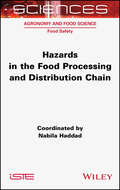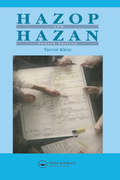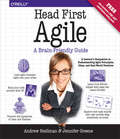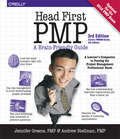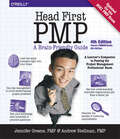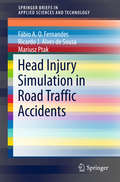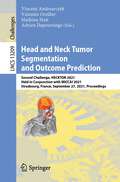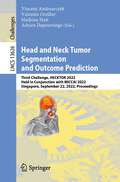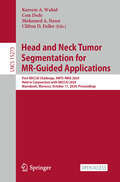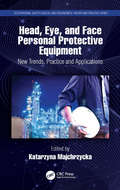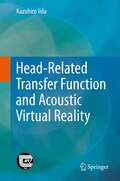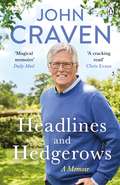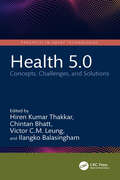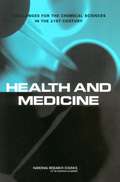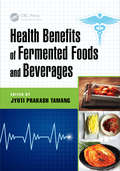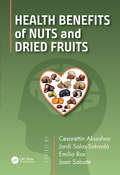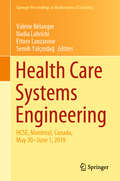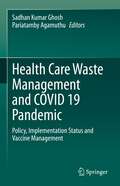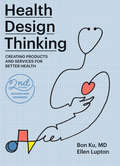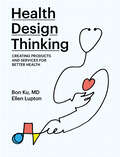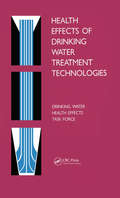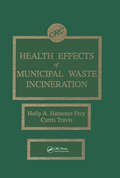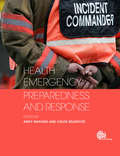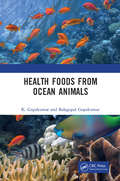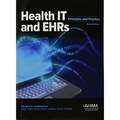- Table View
- List View
Hazards in the Food Processing and Distribution Chain
by Nabila HaddadFoodstuffs can be the vector of a variety of hazards that adversely affect the health of the consumer. Viruses are the leading causes of foodborne infectious diseases, and pathogenic bacteria and bacterial toxins are the leading agents of zoonotic diseases in Europe, not to mention other biological hazards, such as parasites, which can spread to humans through food. In addition to these biological dangers, chemicals used in agriculture, environmental pollutants and additives can all end up on the consumer&’s plate and ultimately damage their health. Hazards in the Food Processing and Distribution Chain covers both chemical and microbiological dangers, aiming to outline the principle of risk analysis with some examples to illustrate the reasoning involved in this process.
Hazop & Hazan: Identifying and Assessing Process Industry Hazards, Fouth Edition
by Trevor A. KletzThis revised edition provides the basics of applying hazard and operability study (Hazop) and hazard analysis (Hazan). Hazop is a creative but systematic method of identifying hazards in process plants. Hazard analysis is then used to quantify the risks from these hazards, and to assess how far to go in reducing them. This book is presented in easy-to-read style and explains: what a Hazop is, who carries it out, when, and how long it should take; points to watch during a Hazop; an example of a Hazop; Hazops on flowsheets; the stages of Hazard analysis; the Fatal Accident Rate; risks to the public; estimating how often an accident will occur, with examples; and pitfalls in Hazan.
Head First Agile: A Brain-Friendly Guide to Agile Principles, Ideas, and Real-World Practices
by Jennifer Greene Andrew StellmanHead First Agile is a complete guide to learning real-world agile ideas, practices, principles.What will you learn from this book?In Head First Agile, you'll learn all about the ideas behind agile and the straightforward practices that drive it. You'll take deep dives into Scrum, XP, Lean, and Kanban, the most common real-world agile approaches today. You'll learn how to use agile to help your teams plan better, work better together, write better code, and improve as a team—because agile not only leads to great results, but agile teams say they also have a much better time at work. Head First Agile will help you get agile into your brain... and onto your team!Preparing for your PMI-ACP® certification?This book also has everything you need to get certified, with 100% coverage of the PMI-ACP® exam. Luckily, the most effective way to prepare for the exam is to get agile into your brain—so instead of cramming, you're learning.Why does this book look so different?Based on the latest research in cognitive science and learning theory, Head First Agile uses a visually rich format to engage your mind, rather than a text-heavy approach that puts you to sleep. Why waste your time struggling with new concepts? This multi-sensory learning experience is designed for the way your brain really works.
Head First PMP
by Jennifer Greene Andrew StellmanLearn the latest principles and certification objectives in The PMBOK Guide, Fourth Edition, in a unique and inspiring way with Head First PMP . The second edition of this book helps you prepare for the PMP certification exam using a visually rich format designed for the way your brain works. You'll find a full-length sample exam included inside the book. More than just proof of passing a test, a PMP certification means that you have the knowledge to solve most common project problems. But studying for a difficult four-hour exam on project management isn't easy, even for experienced project managers. Drawing on the latest research in neurobiology, cognitive science, and learning theory, Head First PMP offers you a multi-sensory experience that helps the material stick, not a text-heavy approach that puts you to sleep. This book will help you:Learn PMP's underlying concepts to help you understand the PMBOK principles and pass the certification exam with flying colors Get 100% coverage of the latest principles and certification objectives in The PMBOK Guide, Fourth Edition, including two new processes: Collect Requirements and Identify Stakeholders Make use of a thorough and effective preparation guide with hundreds of practice questions and exam strategies Explore the material through puzzles, games, problems, and exercises that make learning easy and entertainingHead First PMP puts project management principles into context to help you understand, remember, and apply them -- not just on the exam, but also on the job.
Head First PMP: A Learner's Companion to Passing the Project Management Professional Exam (Head First Ser.)
by Jennifer Greene Andrew StellmanNow updated for the 2021 PMP Exam What will you learn from this book?Head First PMP teaches you the latest principles and certification objectives in The PMBOK® Guide in a unique and inspiring way. This updated fourth edition takes you beyond specific questions and answers with a unique visual format that helps you grasp the big picture of project management. By putting PMP concepts into context, you'll be able to understand, remember, and apply them--not just on the exam, but on the job. No wonder so many people have used Head First PMP as their sole source for passing the PMP exam.This book will help you:Learn PMP's underlying concepts to help you understand the PMBOK principles and pass the certification exam with flying colorsGet 100% coverage of the latest principles and certification objectives in The PMBOK® Guide, Sixth EditionMake use of a thorough and effective preparation guide with hundreds of practice questions and exam strategiesExplore the material through puzzles, games, problems, and exercises that make learning easy and entertainingWhy does this book look so different?Based on the latest research in cognitive science and learning theory, Head First PMP uses a visually rich format to engage your mind, rather than a text-heavy approach that puts you to sleep. Why waste your time struggling with new concepts? This multi-sensory learning experience is designed for the way your brain really works.
Head Injury Simulation in Road Traffic Accidents (SpringerBriefs in Applied Sciences and Technology)
by Ricardo J. Alves de Sousa Mariusz Ptak Fábio A. FernandesIn this work the development of a new geometrically detailed finite element head model is presented. Special attention is given to sulci and gyri modelling, making this model more geometrically accurate than others currently available. The model was validated against experimental data from impact tests on cadavers, specifically intracranial pressure and brain motion. Its potential is shown in an accident reconstruction case with injury evaluation by effectively combining multibody kinematics and finite element methodology.
Head and Neck Tumor Segmentation and Outcome Prediction: Second Challenge, HECKTOR 2021, Held in Conjunction with MICCAI 2021, Strasbourg, France, September 27, 2021, Proceedings (Lecture Notes in Computer Science #13209)
by Vincent Andrearczyk Valentin Oreiller Adrien Depeursinge Mathieu HattThis book constitutes the Second 3D Head and Neck Tumor Segmentation in PET/CT Challenge, HECKTOR 2021, which was held in conjunction with the 24th International Conference on Medical Image Computing and Computer-Assisted Intervention, MICCAI 2021. The challenge took place virtually on September 27, 2021, due to the COVID-19 pandemic.The 29 contributions presented, as well as an overview paper, were carefully reviewed and selected form numerous submissions. This challenge aims to evaluate and compare the current state-of-the-art methods for automatic head and neck tumor segmentation. In the context of this challenge, a dataset of 325 delineated PET/CT images was made available for training.
Head and Neck Tumor Segmentation and Outcome Prediction: Third Challenge, HECKTOR 2022, Held in Conjunction with MICCAI 2022, Singapore, September 22, 2022, Proceedings (Lecture Notes in Computer Science #13626)
by Vincent Andrearczyk Valentin Oreiller Adrien Depeursinge Mathieu HattThis book constitutes the Third 3D Head and Neck Tumor Segmentation in PET/CT Challenge, HECKTOR 2022, which was held in conjunction with the 25th International Conference on Medical Image Computing and Computer-Assisted Intervention, MICCAI 2022, on September 22, 2022.The 22 contributions presented, as well as an overview paper, were carefully reviewed and selected from 24 submissions. This challenge aims to evaluate and compare the current state-of-the-art methods for automatic head and neck tumor segmentation. In the context of this challenge, a dataset of 883 delineated PET/CT images was made available for training.
Head and Neck Tumor Segmentation for MR-Guided Applications: First MICCAI Challenge, HNTS-MRG 2024, Held in Conjunction with MICCAI 2024, Marrakesh, Morocco, October 17, 2024, Proceedings (Lecture Notes in Computer Science #15273)
by Kareem A. Wahid Cem Dede Mohamed A. Naser Clifton D. FullerThis Open Access book constitutes the refereed proceedings of the First MICCAI Challenge, HNTSMRG 2024, Held in Conjunction with MICCAI 2024, in Marrakesh, Morocco, on October 17, 2024. The 20 full papers and 1 overview paper included in this volume were carefully reviewed and selected from a total of 21 submissions. The HNTS-MRG 2024 Challenge focuses on advancing clinical workflows by leveraging artificial intelligence (AI) for automated segmentation of tumor regions in multi-timepoint MRI scans.
Head, Eye, and Face Personal Protective Equipment: New Trends, Practice and Applications (Occupational Safety, Health, and Ergonomics)
by Katarzyna MajchrzyckaHead, Eye, and Face Personal Protective Equipment: New Trends, Practice, and Applications presents protective equipment in the context of the latest design trends, materials, and technologies. It informs the reader using basic safety principles to avoid issues with commonly used personal protective equipment (PPE), such as helmets and eye and face protectors. It provides the latest design trends in eye and face protectors to avoid optical hazards and for use in variable lighting conditions. Features: • Fills the gap on current solutions of PPE and occupational safety • Educates in reducing risk connected with using industrial safety gear • Helpful to optometrists in the selection of eye protection for people with visual impairments • Instructs the reader on choosing smart materials and safety products • Provides best practices for checking the technical condition of the equipment This book is essential for the safety professional and medical experts in the field. It provides an interdisciplinary approach to personal protective equipment using new technologies in the field. "The monograph Head, Eye, and Face Personal Protective Equipment - New Trends, Practice and Applications is a complementary and thoughtful but selected compilation of the most relevant information concerning protective helmets as well as eye and face protection. The compilation of these two protection types is the result of the common use of both protective helmets and eye and face protectors. This requires their full compatibility, both in terms of ensuring optimum safety and comfort of use. The authors have chosen the material according to the needs of people directly responsible for safety at work and users of those protectors. The main aim of the work is to popularise knowledge in the field of construction, research methods, selection and use of protective helmets and eye and face protectors. In terms of use, the authors emphasise the necessity of independent control, i.e. checking the technical condition of the equipment used by the end users. The presented monograph includes the current state of knowledge in this scope, extended by the results and summaries of the authors' own research. All requirements and research methods are given based on European (EN), international (ISO) standards and standards operating in different geographical areas. The monograph also encompasses new trends in the design of protective helmets and eye and face protectors. All this allows me to emphasize the uniqueness of this monograph in relation to previous publications in this field, both in terms of the scope and selection of information concerning protective helmets and eye and face protectors."— Ryszard Korycki, Łódź University of Technology
Head-Related Transfer Function and Acoustic Virtual Reality
by Kazuhiro IidaThis book covers all aspects of head-related transfer function (HRTF), from the fundamentals through to the latest applications, such as 3D sound systems. An introductory chapter defines HRTF, describes the coordinate system used in the book, and presents the most recent research achievements in the field. HRTF and sound localization in the horizontal and median planes are then explained, followed by discussion of individual differences in HRTF, solutions to this individuality (personalization of HRTF), and methods of sound image control for an arbitrary 3D direction, encompassing both classic theory and state of the art data. The relations between HRTF and sound image distance and between HRTF and speech intelligibility are fully explored, and measurement and signal processing methods for HRTF are examined in depth. Here, supplementary material is provided to enable readers to measure and analyze HRTF by themselves. In addition, some typical HRTF databases are compared. The final two chapters are devoted to the principles and applications of acoustic virtual reality. This clearly written book will be ideal for all who wish to learn about HRTF and how to use it in their research.
Headlines and Hedgerows: A Memoir
by John CravenTake a trip down memory lane with the memoir from national TV treasure John Craven, as he recounts both the highs and lows of one of the longest entertaining careers in history, and the people and animals that have helped to shape it. _______'A cracking read' Chris Evans, Virgin Radio Breakfast Show_______He began by reading the front page of the evening newspaper in the kitchen to his mother and aunt. Since then he's spoken into microphones to the nation on the BBC almost every week for more than half a century and is one of the most-beloved broadcasters of our time. Presenter of treasured programmes Newsround, Countryfile and Swap Shop, John brought us the headlines and breaking news of our childhood and later helped us discover the magic and wonder of the British countryside. Now, in his first ever autobiography, he recounts a life in news starting with the Grimthorpe Street Gazette, the handwritten newspaper he produced in his early teens - just one copy at a time, so small beginnings. Later, broadcasting on television to millions of children, his casual style of news-reading even found his jumpers making news. He writes about his childhood, his career and the people, events - and animals - that have shaped his life. This is John Craven. And this is the story behind the man so many of us grew up watching on our television screens._______'Magical memoirs. A BBC legend. A broadcasting icon. The best bits from cub reporter to Countryfile . . . his early career sounds like a riot' Daily Mail
Health 5.0: Concepts, Challenges, and Solutions (Prospects in Smart Technologies)
by Victor C.M. Leung Chintan Bhatt Hiren Kumar Thakkar Ilangko BalasinghamThis book presents a detailed explanation of the concepts, taxonomy, and challenges in Healthcare 4.0 and provides frameworks and architectures for the adaptation and fusion of emerging technologies under Healthcare 5.0. The healthcare industry requires technological upgrades to provide precise, accurate, and automatic remote health monitoring and diagnosis. This reference book offers an early opportunity to explore emerging technologies and understand current issues, problems, and concepts.Health 5.0: Concepts, Challenges, and Solutions provides state-of-the-art research topics and opportunities of IoMT in personalized healthcare. It presents diversified IoMT applications for smart healthcare that supports lifestyle changes as a preventive measure and discusses health and care for all citizens to lead a good quality of life. The book illustrates the advancements of IoMT in augmented reality and AI and offers use-cases of edge computing for remote healthcare. The book also highlights the architectures, frameworks, and current research issues in IoMT and goes on to focus on sustainable healthcare for smart cities using edge computing, IoMT, and big data. The details of the development of advanced therapeutic instrumentation, along with the promotion of digital therapy, are also provided.The primary audience for this book includes academicians, researcher scholars, IoMT developers, cloud-based health application designers, and medical practitioners who are engaged in providing healthcare services using recent technologies.
Health And Medicine
by Medicine Organizing Committee For The Workshop On HealthThe report assesses the current state of chemistry and chemical engineering within the context of drug discovery, disease diagnosis, and disease prevention. Also addressed are chemical and chemical engineering challenges in pharmaceutical synthesis, delivery, and manufacture.
Health Benefits of Fermented Foods and Beverages
by Jyoti Prakash TamangHealth Benefits of Fermented Foods and Beverages discusses the functionality and myriad health benefits of fermented foods and beverages of the world. It examines health-promoting and therapeutic properties, covering the molecular process of fermentation and the resulting benefit to nutritional value and long-term health. Exploring a range of ferme
Health Benefits of Nuts and Dried Fruits
by Cesarettin Alasalvar Jordi Salas-Salvadó Emilio Ros Joan SabatéNuts and dried fruits are part of our daily diet. They are consumed whole or as ingredients of many food products such as muffins, cereals, chocolates, energy bars, breads, and cookies, among others. Health Benefits of Nuts and Dried Fruits provides a comprehensive overview of the literature on the health benefits of nuts and dried fruits. The book summarizes the current state of knowledge in key research areas and provides ideas for future scientific research and product development. Nuts, a term that comprises tree nuts and peanuts, are highly nutritious, containing health-promoting macronutrients, micronutrients, vitamins, and bioactive phytochemicals; they are one of the edible foods with the highest content in antioxidants. The consumption of nuts is recognized for its health-promoting properties, which ranges from a consistent cholesterol-lowering effect in clinical trials to a robust association with reduced risk of cardiovascular disease and all-cause mortality in prospective studies. In spite of the high energy content of nuts, there is no evidence that their frequent consumption promotes obesity, and they may even help control it. Dried fruits, which serve as important healthful snacks worldwide, are nutritionally equivalent to fresh fruits while providing all of their bioactive components in concentrated form. While the evidence level concerning the health effects of dried fruits lags behind that on nuts, it suggests that individuals who consume dried fruits regularly have a lower risk of cardiovascular disease, obesity, and other non-communicable diseases. Main features of the book concerning nuts and dried fruits: • Provides detailed information on health effects • Highlights current regulation and health claims • Provides updated dietary recommendations • Describes nutrient absorption and metabolism • Discusses mechanisms implicated in the health effects Although this book is intended primarily as a reference, by comprehensively reviewing the current state of knowledge it can guide future research on the topic. Among others, food scientists, biochemists, nutritionists, health professionals, decision makers, and regulatory agencies can draw much benefit from its contents. Hopefully, it will help in public health strategies to promote healthy aging and improve population wellbeing.
Health Care Systems Engineering: HCSE, Montréal, Canada, May 30 - June 1, 2019 (Springer Proceedings in Mathematics & Statistics #316)
by Ettore Lanzarone Valérie Bélanger Nadia Lahrichi Semih YalçındağThis book presents the proceedings of the Fourth International Conference on Health Care Systems Engineering (HCSE 2019), which took place in Montreal, Canada, from May 30 to June 1, 2019. The event took place in the mother and child university hospital CHU Sainte-Justine in Montréal, and each session was co-chaired by a discussant coming from the clinical practice.The conference offered scientists and practitioners an opportunity to discuss operations management issues in health care delivery systems, and to share new ideas, methods and technologies for improving the operation of health care organizations.Focusing on applications of systems engineering, optimization and statistics to improve health care delivery and health systems, the book covers topics relating to a broad spectrum of concrete problems that pose challenges for researchers and practitioners alike, including hospital drug logistics, operating theatre management, blood donation, home care services, modeling, simulation, process mining and data mining in patient care and health care organizations.
Health Care Waste Management and COVID 19 Pandemic: Policy, Implementation Status and Vaccine Management
by Pariatamby Agamuthu Sadhan Kumar GhoshThis book deals with the general principles, policy instruments, sustainability of supply chain, and business of health-care waste (HCW) management including inputs on exercise in immune health defense against COVID 19. Health-care waste management is very important in any country for protection of environmental and animal and human health. The COVID-19 pandemic, in addition, has augmented this importance to a greater extent. Italy has been successful in curbing the problems related to HCW management during the COVID-19 pandemic at very fast rates from the worst situation, while for a few countries in Asia and Africa, challenges still exist. It is necessary that policy makers, researchers, and implementers gain more knowledge and information on these aspects and improve the strategies and actions. Addressing these issues will reduce the cost of health care as well as resource inefficiency hindering sustainable development goals. This book is of interest and useful to practitioners, capacity builders and policy makers, entrepreneurs, NGOs, and general people, and is a valuable source of reference to the relevant researchers and students in global markets. The book serves as a reading material for undergraduate and graduate students of environmental science, waste management, and medical science. National and international scientists as well as policy makers will also find this to be a useful read.
Health Design Thinking, second edition: Creating Products and Services for Better Health
by Ellen Lupton Bon KuA practice-based guide to applying the principles of human-centered design to real-world health challenges; updated and expanded with post–COVID-19 innovations. This book offers a practice-based guide to applying the principles of human-centered design to real-world health challenges that range from drug packaging to breast cancer detection. Written by pioneers in the field—Bon Ku, a physician leader in innovative health design, and Ellen Lupton, an award-winning graphic designer—the book outlines the fundamentals of design thinking and highlights important products, prototypes, and research in health design. This revised and expanded edition describes innovations developed in response to the COVID-19 crisis, including an intensive care unit in a shipping container, a rolling cart with intubation equipment, and a mask brace that gives a surgical mask a tighter seal. The book explores the special overlap of health care and the creative process, describing the development of such products and services as a credit card–sized device that allows patients to generate their own electrocardiograms; a mask designed to be worn with a hijab; improved emergency room signage; and a map of racial disparities and COVID-19. It will be an essential volume for health care providers, educators, patients, and designers who seek to create better experiences and improved health outcomes for individuals and communities.
Health Design Thinking: Creating Products and Services for Better Health
by Ellen Lupton Bon KuApplying the principles of human-centered design to real-world health care challenges, from drug packaging to early detection of breast cancer.This book makes a case for applying the principles of design thinking to real-world health care challenges. As health care systems around the globe struggle to expand access, improve outcomes, and control costs, Health Design Thinking offers a human-centered approach for designing health care products and services, with examples and case studies that range from drug packaging and exam rooms to internet-connected devices for early detection of breast cancer. Written by leaders in the field—Bon Ku, a physician and founder of the innovative Health Design Lab at Sidney Kimmel Medical College, and Ellen Lupton, an award-winning graphic designer and curator at Cooper Hewitt Smithsonian Design Museum—the book outlines the fundamentals of design thinking and highlights important products, prototypes, and research in health design.Health design thinking uses play and experimentation rather than a rigid methodology. It draws on interviews, observations, diagrams, storytelling, physical models, and role playing; design teams focus not on technology but on problems faced by patients and clinicians. The book's diverse case studies show health design thinking in action. These include the development of PillPack, which frames prescription drug delivery in terms of user experience design; a credit card–size device that allows patients to generate their own electrocardiograms; and improved emergency room signage. Drawings, photographs, storyboards, and other visualizations accompany the case studies.Copublished with Cooper Hewitt, Smithsonian Design Museum
Health Effects of Drinking Water Contaminants
by Edward J. CalabreseThis new book evaluates the risks and benefits of the widely used types of drinking water treatment technologies, based on assessment and comparison of chemicals used in treatment, by-products of chemicals, and non-treatment. This valuable material was prepared by independent experts in drinking water treatment technology and toxicology, in conjunction with EPA.
Health Effects of Municipal Waste Incineration
by Curtis C. Travis Holly A. Hattemer-FreyThis much-needed book provides an enlightening perspective on the environmental and human health impacts of municipal solid waste (MSW) incineration. Over 100 tables and figures allows speedy access to important data you will refer to again and again. The comprehensive text assesses the human health risks associated with exposure to facility emitted pollutants-especially the highly toxic dioxin. It includes an evaluation of multipathway (inhalation and food chain) exposures. This essential publication also evaluates facility emissions, plausible air concentrations, the potential for deposition of pollutants onto plant, soil, and water surfaces, the movement and accumulation of pollutants through environmental media, and the potential for human exposure. Health Effects of Municipal Waste Incineration is an up-to-date volume which encourages readers to formulate opinions about some of the fundamental issues affecting the management of municipal solid waste. Anyone involved with environmental science, hazardous waste, toxicology, risk analysis and/or environmental engineering will certainly value and utilize this well-written resource.
Health Emergency Preparedness and Response
by Chloe Sellwood Andy WaplingIntensely practical and down-to-earth, this timely new text covers the breadth of health emergency preparedness, resilience and response topics in the context of inter-disciplinary and whole society responses to a range of threats. It includes public, private and third sector roles in preparation for and in response to natural and man-made events, such as: major incident planning; infectious disease epidemics and pandemics; natural disasters; terrorist threats; and business and service continuity management. The book builds upon the basics of risk assessment and writing an emergency plan, and then covers inter-agency working, command and control, communication, personal impact and business continuity as well as training, exercises and post-incident follow up. Detailing the full emergency preparedness and civil protection planning cycle, the book is illustrated throughout with real-life examples and case studies from global experts in the field for countries with both advanced and developing healthcare systems. This practical handbook covering the essential aspects of major incident and disaster management is ideal for undergraduate and master's students in emergency management and public health, as well as for practitioners in emergency preparedness and civil protection. It will be valuable to all health practitioners from ambulance, hospital, primary and community care, mental health and public health backgrounds.
Health Foods from Ocean Animals
by K. Gopakumar Balagopal GopakumarMarine animals and their body constituents have been in use by mankind for nutrition and medical applications centuries ago. This book contains some well known and lesser known compounds from some important marine animals those have been consumed by man for centuries. This is the first book in this field and will serve as a reference for future researchers in the field. Note: T&F does not sell or distribute the Hardback in India, Pakistan, Nepal, Bhutan, Bangladesh and Sri Lanka.
Health IT and EHRs: Principles and Practice
by Margret K. AmatayakulThis sixth edition is being renamed Health IT and EHRs as a result of the expanded scope of the technology needed for all health information collection and use. The sixth edition is also focused more on serving as a textbook in addition to serving as a reference work for readers who work in any health setting, whether a healthcare provider organization, vendor, health plan, or policy-maker. The book introduces the full scope of health IT in chronological fashion, covering the information systems development life cycle, strategic planning, goal setting workflow and process mapping, change management, vendor selection, project management, and implementation, training, and ongoing maintenance of EHR and other health IT systems. It also addresses the essential elements of data infrastructure, information technology, privacy and security, and interoperability for all forms of health IT. Finally, there is considerable expansion in chapters covering techniques to achieve value with health IT in various acute care, ambulatory care, and specialty care settings as well as for consumer health IT, enterprise content and record management as an EHR bridge technology, revenue cycle management, and population health. Those familiar with the fifth edition of Electronic Health Records: A Practical Guide for Professionals and Organizations will find that some of the chapters have been moved around, consolidated, or expanded in the sixth edition. Two chapters have been added, on revenue cycle management and population health, given expanded interest in integrating information on clinical, administrative or financial, and social determinants of health.
